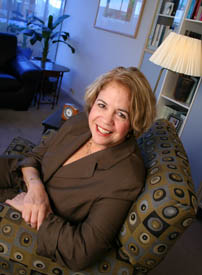Psychoanalysis—Couch and All—Still Going Strong
 As president-elect of the American Psychoanalytic Association (APsaA), Prudence Leib Gourguechon, MD, GME ’83, wants people to know that the field of psychoanalysis is alive and well and helping many people who don’t respond to quicker therapies.
As president-elect of the American Psychoanalytic Association (APsaA), Prudence Leib Gourguechon, MD, GME ’83, wants people to know that the field of psychoanalysis is alive and well and helping many people who don’t respond to quicker therapies.
“My patients have usually been in psychotherapy or on medication for 10â20 years,” she says. “They have tried several therapists and several medications. But it hasn’t worked because their issues can’t be addressed by less intensive therapy.” So when they seek her out hoping for yet another psychiatrist to help them make things better, she sometimes suggests analysis.
The mother of all talk therapy, psychoanalysis is based on the theories of Sigmund Freud and focuses on the stories of patients’ lives and the meaning of their experiences. Once patients understand why they keep making the same kinds of mistakes, they can take different actions in the future. The therapy is an investment in time and money, with patient and analyst meeting four to five times per week, sometimes for years. Most health insurance plans will not cover the process, but the intensity of the therapy allows the patient to chip away at psychological barriers, a process Freud linked to archeological “excavation.”
Psychoanalysis was a basic component of the Feinberg School psychiatry program when Dr. Gourguechon completed her residency here after earning her medical degree from the University of Michigan. She recalls the impact that Leon Diamond, MD, associate professor emeritus, and the late Harold M. Visotsky, MD, department chair and professor emeritus, had upon her career. After leaving Northwestern, she attended the Chicago Institute for Psychoanalysis, where she later served as the first student member of the board of directors.
Dr. Gourguechon’s greatest challenges are the isolation of being a solo practitioner and allowing herself to absorb her patients’ pain. “You are trying your best to be open to people’s pain and really listen to it, whereas the rest of the world is trained to block it out,” she explains. She adds balance to her life through her family life as well as her work with the APsaA, made up of 3,500 members including psychiatrists, psychologists, social workers, academicians, and counselors. She has served as secretary of the group for two years and in 2008 will become its sixth woman president. “We have a wonderful government relations program and are one of the most successful advocates for patient privacy,” she says. The group lobbies fiercely regarding several medical privacy issues including national electronic medical record-keeping. “We can’t do what we do if privacy isn’t bedrock,” she says.
While some of Freud’s theoretical constructs have fallen away—”We don’t talk about killing your father and marrying your mother too much anymore,” she jokes—the couch has stuck. Taking up most of one wall in her suburban Chicago office, her sleek black leather model beckons patients to relax and feel safe. Behind the couch sits Dr. Gourguechon, close but out of sight. “If you think about talking to someone face to face, including a therapist, there is a tremendous amount of visual cuing,” she says. “We’re constantly scanning the other person’s face to see if they’re interested or if they like what we’re saying.” The arrangement offers “the possibility of going deep within one’s mind without the distractions of the social setting.”
The most satisfying part of her clinical work is the pleasure of helping people change their lives. She notes that often her patients look fine and seem to be successful in the world but have great difficulty making loving attachments and finding work that satisfies them. “When you find individuals who can’t do these things for themselves and you help them transform their lives, nothing is more wonderful,” she adds.
(Excerpted from the Winter 2006â07 issue of Ward Rounds.)






